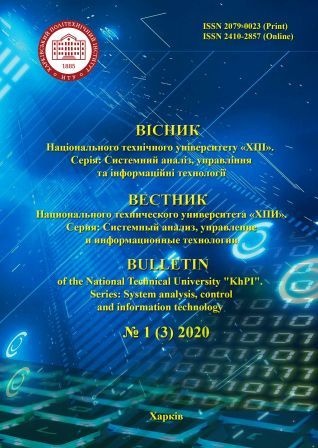EXPLANATION MODEL IN AN INTELLIGENT INFORMATION SYSTEM BASED ON THE CONCEPT OF KNOWLEDGE COHERENCE
DOI:
https://doi.org/10.20998/2079-0023.2020.01.04Keywords:
knowledge, coherence of knowledge, intelligent system, recommendations, explanations, requirements for explanationsAbstract
The subject of the research is the processes of constructing explanations of the results obtained in intelligent information systems. Explanations make transparent the process of creating the resulting recommendation, create the conditions for the user to create causal links between the result of the conclusion and the current problems for which the intelligent system was used. The aim is to develop an explanation model in an intelligent system with the ability to provide a consistent interpretation with the results of such a system, taking into account context-oriented requirements for user needs. To achieve this goal, the tasks of defining the requirements for explanation of the results of the information system, as well as developing a model of explanation based on the principles of knowledge coordination in order to obtain recommendations based on the facts, hypotheses, results. It is shown that when coordinating the interests of the user and the capabilities of the intelligent system, it is necessary to detail the knowledge taking into account the range of relevance of data and knowledge, as well as financial and technical and other features of the results. A model of explanation in an intelligent system based on the coordination of knowledge and data is proposed. The model contains many agreed facts, hypotheses and results. Reconciliation is performed for hypotheses that are subsets of other hypotheses, based on explanations of hypotheses through facts and other hypotheses, as well as on the basis of the correspondence between the obtained results and hypotheses. The model makes it possible to limit the use of implicit and inaccurate knowledge in the output only to their agreed subset. In practical terms, the use of the model is focused on constructing explanations taking into account the level of abstraction, the degree of detail of the description of the subject area, as well as taking into account the sel ected aspect of interpretation of the received recommendation. In general, the formation of explanations based on the harmonization of knowledge increases user confidence and creates conditions for the effective use of the received recommendations.References
Cunningham P., Doyle D., Loughrey J. An evaluation of the usefulness of case-based reasoning explanation. Proceedings of the International Conference on Case-Based Reasoning. ICCBR 2003. Trondheim, Springer, 2003, pp. 122–130.
Swartout W., Moore J. Explanation in Second Generation Expert Systems. Second Generation Expert Systems. 1993, pp. 543–585.
Cleger S., Fernбndez-Luna J., F Huete J. Learning from explanations in recommender systems. Information Sciences. 2014, vol. 287, pp. 90–108.
Chalyi S., Leshchynskyi V., Leshchynska I. Method of forming recommendations using temporal constraints in a situation of cyclic cold start of the recommender system. EUREKA: Physics and Engineering. 2019, vol. 4, pp. 34–40.
Chalyi S. F., Leshchynskyi V. O., Leshchynska I. O. Modelyuvannya poyasnen shodo rekomendovanogo pereliku ob’yektiv z urahuvannyam temporalnogo aspektu viboru koristuvacha [Modeling explanations for the recommended list of items based on the temporal dimension of user choice]. Sistemi upravlinnya, navigaciyi ta zv’yazku [Control, Navigation and Communication Systems]. 2019, vol. 6, no. 58, pp. 97–101.
Levykin V., Chala O. Method of determining weights of temporal rules in markov logic network for building knowledge base in information control system. EUREKA: Physics and Engineering. 2018, vol. 5, pp. 3–10.
Levykin V., Chala O. Development of a method for the probabilistic inference of sequences of a business process activities to support the business process management. Eastern-European Journal of Eenterprise Technologies. 2018, vol. 5/3(95), pp. 16–24.
Daher J, Brun A., Boyer A. A. A review on explanations in recommender systems. Technical Report. LORIA Université de Lorraine, 2017. 26 p. URL: https://hal.archives-ouvertes.fr/hal01836639/document (accessed: 18.05.2020).
Thagard P., Verbeurgt K. Coherence as constraint satisfaction. Cognitive Science. 1998, vol. 22, pp. 1–24.
Thagard P. Coherence, truth, and the development of scientific knowledge. Philosophy of Science. 2007, vol, 74, pp. 28–47.
Thagard P. Causal inference in legal decision making: Explanatory coherence vs. Bayesian networks. Applied Artificial Intelligence. 2004, vol. 18, pp. 231–249.
Tintarev N., Masthoff J. A survey of explanations in recommender systems. 3rd international workshop on web personalisation, recommender systems and intelligent user interfaces (WPRSIUI'07). 2007, pp. 801–810. URL: https://abdn.pure.elsevier.com/ en/publications/a-survey-of-explanations-in-recommender-systems (accessed: 17.05.2020).
Tintarev N., Masthoff J. Designing and Evaluating Explanations for Recommender Systems. Recommender Systems Handbook. 2010, pp. 479–510.
Downloads
How to Cite
Issue
Section
License
Copyright (c) 2020 Bulletin of National Technical University "KhPI". Series: System Analysis, Control and Information TechnologiesAuthors who publish with this journal agree to the following terms:
- Authors retain copyright and grant the journal right of first publication with the work simultaneously licensed under a Creative Commons Attribution License that allows others to share the work with an acknowledgement of the work's authorship and initial publication in this journal.
- Authors are able to enter into separate, additional contractual arrangements for the non-exclusive distribution of the journal's published version of the work (e.g., post it to an institutional repository or publish it in a book), with an acknowledgement of its initial publication in this journal.
- Authors are permitted and encouraged to post their work online (e.g., in institutional repositories or on their website) prior to and during the submission process, as it can lead to productive exchanges, as well as earlier and greater citation of published work (See The Effect of Open Access).


